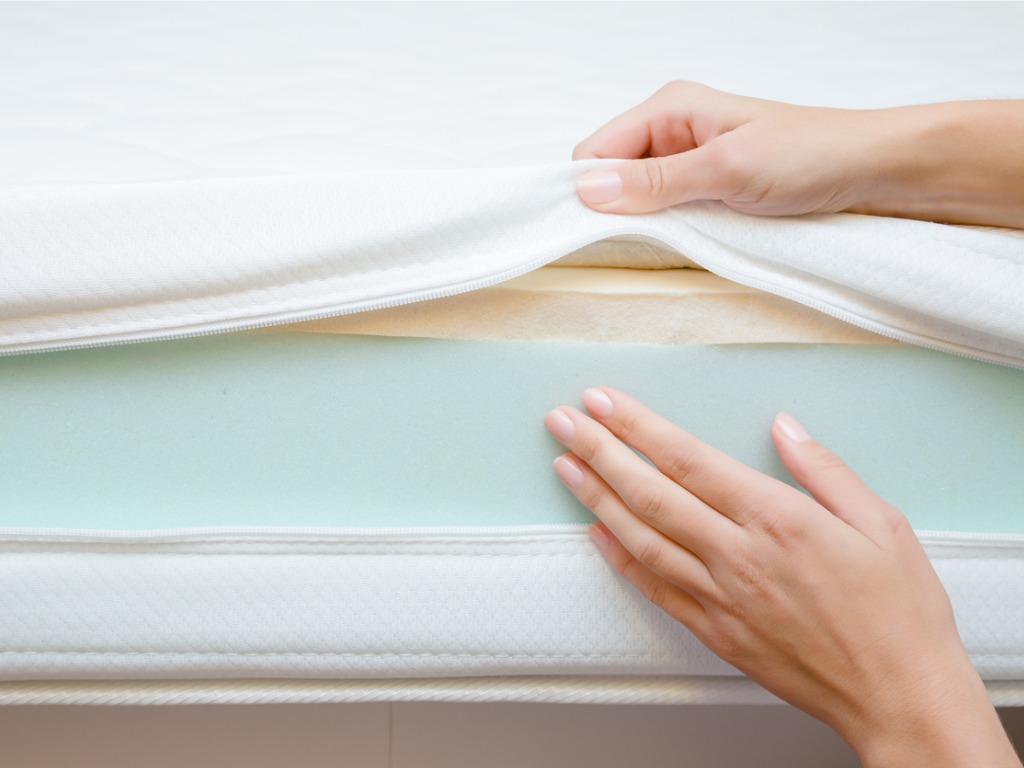Why Do Mattresses Contain Fiberglass?

The Bottom Line
Fiberglass is often used by mattress manufacturers to meet fire safety standards. Fiberglass may be present in mattress foam or covers, and human exposures to fiberglass can occur when mattress covers are unzipped or removed. Health effects from fiberglass exposure can include eye injuries, skin irritation, and lung disease.

Why do mattresses need to be fire resistant?
More than 25% of all fires occur in home environments, and at least 2,500 deaths and 11,000 injuries related to home fires occur each year. The two most common items implicated in home fire deaths are upholstered furniture and mattresses/bedding. Because of this, the United States Consumer Product Safety Commission (CPSC) established the first fire safety standards for mattresses in the early 1970’s. While the initial CPSC standards were aimed at reducing the number of cigarette-related mattress fires, the most recent standard focuses on limiting the rate and extent of mattress fire spread. Many mattress and bedding manufacturers use flame-retardant chemicals to maintain compliance with the new CPSC standard.
Why are flame-retardant chemicals used in mattresses?
Flame-retardant chemicals slow the burning process of treated materials, including mattresses, car seats, and cell phones. By slowing the burning process, flame-retardant chemicals increase the time available for individuals to escape from fires.What are some chemicals that are used in mattresses as flame retardants?
There are hundreds of different flame-retardant chemicals. Polybrominated biphenyls and polybrominated diphenyl ethers (PBDE’s), which were commonly used as flame retardants in the late 20th century, have been banned and are no longer produced due to concerns about adverse health effects. Organophosphate flame retardants (OPFR’s) were introduced as replacements for PBDE’s, but may also cause neurologic toxicity. Fiberglass, which acts as a thermal insulation barrier during fires, can be incorporated into mattress or bedding fibers as a flame-retardant agent.What is fiberglass?
Fiberglass is a type of man-made mineral fiber. that are composed of silica sand, limestone, recycled glass, and soda ash. Fiberglass is often used as a cost-effective and long-lasting insulating material, as it has a lifespan of more than 50 years and does not need to be replaced on a regular basis. Fiberglass is also commonly utilized as a flame-retardant agent due to its heat-resistant properties.Which mattresses contain fiberglass?
To help mattress manufacturers meet fire-resistant standards, fiberglass may be present within mattress covers or foam. While some mattresses are certified as being free of heavy metals and hazardous flame-retardant chemicals, these guarantees apply to the mattress foam only, and chemicals may still be present in mattress covers. When individuals unzip or open mattress covers, unintentional exposures to fiberglass can occur. In one study, fiberglass was detected in the covers of mattresses manufactured by Zinus and Graco that were certified as having chemical-free foam. Since fiberglass is present in many mattresses, it can be difficult to tell whether a specific mattress contains fiberglass in the foam or cover. The mattress label, which lists the components of the mattress, may or may not contain the terms “fiberglass”, “glass fiber”, or “glass wool” if fiberglass is present within the mattress or its cover.Is fiberglass dangerous?
Fiberglass can be irritating to the eyes, skin, and lungs. Rashes, itching, and blisters can occur when fiberglass comes into contact with human skin, even for short periods of time. Long-term exposure to fiberglass is associated with lung disease, including pulmonary fibrosis. Short-term inhalational exposure to fiberglass may cause lung inflammation and bronchiolitis. Fiberglass fibers can also cause visual changes, bleeding, and scarring if they become embedded within the eye.What should I do if fiberglass makes me sick?
If you experience a worrisome exposure to household products, get guidance from Poison Control immediately. Help from poison control is available online at webPOISONCONTROL and by phone at 1-800-222-1222. Both options are free, confidential, and available 24 hours a day.Kelly Johnson-Arbor, MD
Medical Toxicologist
For media inquiries, please contact Krista Osterthaler at osterthaler@poison.org.
Poisoned?
Call 1-800-222-1222 or
Prevention Tips
- Contact your mattress manufacturer if you have questions about the mattress’ contents.
- Follow directions on product labels: if a mattress cover is labeled “do not remove”, avoid unzipping it.
- Do not touch or allow children to play with fiberglass home insulation.
This Really Happened
Two children, age 5 months and 9 years, experienced multiple medical issues including sores, rashes, and asthma exacerbations. The children’s mother believed that fiberglass fibers in her Zinus “Green Tea” mattress migrated out of the mattress and caused her children’s symptoms. The children’s mother filed a class-action lawsuit against Zinus, Inc., claiming damages of at least twenty thousand dollars.For More Information
Fibrous Glass (The National Institute for Occupational Safety and Health)
References
Poisoned?
Call 1-800-222-1222 or
Prevention Tips
- Contact your mattress manufacturer if you have questions about the mattress’ contents.
- Follow directions on product labels: if a mattress cover is labeled “do not remove”, avoid unzipping it.
- Do not touch or allow children to play with fiberglass home insulation.
